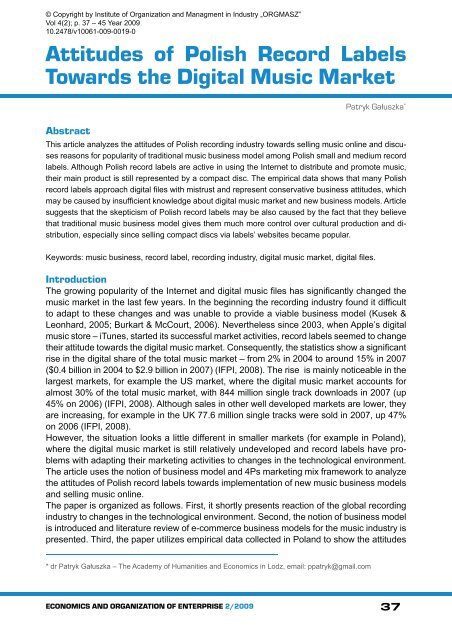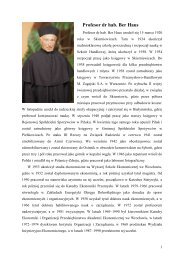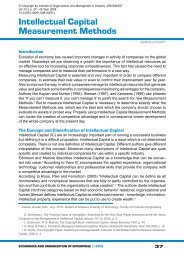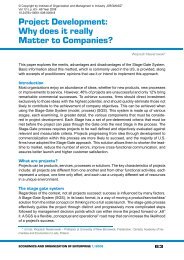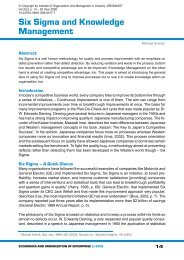Attitudes of Polish Record Labels Towards the Digital Music Market
Attitudes of Polish Record Labels Towards the Digital Music Market
Attitudes of Polish Record Labels Towards the Digital Music Market
- No tags were found...
You also want an ePaper? Increase the reach of your titles
YUMPU automatically turns print PDFs into web optimized ePapers that Google loves.
<strong>Attitudes</strong> <strong>of</strong> <strong>Polish</strong> <strong>Record</strong> <strong>Labels</strong> <strong>Towards</strong> <strong>the</strong> <strong>Digital</strong> <strong>Music</strong> <strong>Market</strong>The compact disc serves as <strong>the</strong> technological basis for all <strong>the</strong> mentioned above products.One <strong>of</strong> <strong>the</strong> reasons why most <strong>of</strong> <strong>the</strong> <strong>Polish</strong> record labels are skeptical about new digital musictechnologies is <strong>the</strong>ir inability to categorize music files as albums or compilation albums. Thefact that music files are released as tracks, which are not always bundled into albums, andcan be bought by customers as per item, seems to be a serious concern for <strong>the</strong> labels. If aconsumer cherry-picks only three tracks from 12 songs long album, labels perceive it not asthree tracks sold, but nine tracks not bought (interview number 9).Only <strong>the</strong>se firms which describe <strong>the</strong>mselves as netlabels declared that <strong>the</strong>ir main productis a music file. It is difficult to estimate <strong>the</strong> exact number <strong>of</strong> netlabels, as <strong>the</strong>re is no cleardefinition <strong>of</strong> a netlabel. Generally about 10% <strong>of</strong> <strong>the</strong> firms which took part in <strong>the</strong> researchtreat music files as <strong>the</strong> main preferred audio format. Most <strong>of</strong> <strong>the</strong>m employ <strong>the</strong> “free music”business model – <strong>the</strong>y distribute music files for free and treat it as a promotional vehicle,which helps artists get listeners’ and media attention and also helps <strong>the</strong>m to earn moneyfrom o<strong>the</strong>r sources (e.g. concerts or music publishing) (interview 5).Distribution: selling tangible products in virtual storesPhysical distribution <strong>of</strong> compact discs is a key element <strong>of</strong> <strong>the</strong> traditional music business model.Many small record labels are unable to organize efficient physical distribution <strong>of</strong> <strong>the</strong>ir products,which is <strong>of</strong>ten <strong>the</strong> main reason for <strong>the</strong>ir market failure. The demand for music products isvery unstable and hard to predict, which makes uncertainty <strong>the</strong> most characteristic feature<strong>of</strong> <strong>the</strong> music business (Lewis, 1986). It is estimated that only one record in every nine is ahit, while <strong>the</strong> o<strong>the</strong>r eight generate loses (Hesmondhalgh, 2002). Consequently, <strong>the</strong> retailersare very careful when choosing which products <strong>the</strong>y sell. Small record labels rarely haveenough clout to make <strong>the</strong>ir products widely available, thus <strong>the</strong>y should be <strong>the</strong> first to employnew business models, which give <strong>the</strong>m more control over <strong>the</strong> distribution chain.In <strong>the</strong> music business, choosing a distributor is important not only from an economic butalso an ideological point <strong>of</strong> view. The most powerful distributors are affiliated (or are a part<strong>of</strong>) major record companies. <strong>Record</strong> companies, which manage to distribute <strong>the</strong>ir productswithout employing major-label distributors are called independent record labels. Such firmsdistribute <strong>the</strong>ir products by <strong>the</strong>mselves or employ independent distributors. The distinctionbetween major record companies (or <strong>the</strong>se labels which are affiliated with majors) and independentrecord labels is an essential part <strong>of</strong> “creativity and commerce” discourse, whichis important to many fans, musicians, journalists and scholars in various genres <strong>of</strong> popularmusic (Negus, 1995). They believe that independent record labels, which have no ties withmajor record companies, give musicians more artistic freedom, tend to be less bureaucraticand exploitative (Lee, 1995). Even though <strong>the</strong> history <strong>of</strong> popular music shows that in manycases this was not true (Hesmondhaldh, 1999), <strong>the</strong>re is a general belief that “doing-it-yourself”- recording and selling music without <strong>the</strong> support from major record labels – democratizespopular music and has a positive impact on <strong>the</strong> quality <strong>of</strong> records (Lee, 1995; Hesmondhalgh,1999; Moore, 2007; Strachan 2007).Consequently, <strong>the</strong>re are at least two arguments why smaller record labels should be interestedin introducing new forms <strong>of</strong> distribution via <strong>the</strong> digital music stores: a) <strong>of</strong>ten it is easierto sell digital files than to convince traditional retailers to sell niche products; b) selling musicon <strong>the</strong> Internet means reaching listeners in a more direct way and it brings <strong>the</strong> record labelscloser to <strong>the</strong> “doing-it-yourself” ideal than any o<strong>the</strong>r form <strong>of</strong> traditional distribution.Never<strong>the</strong>less, data collected in <strong>the</strong> survey shows that <strong>Polish</strong> small and medium record labelsseem to prefer traditional distribution channels (table 3).ECONOMICS AND ORGANIZATION OF ENTERPRISE 2/200943
<strong>Attitudes</strong> <strong>of</strong> <strong>Polish</strong> <strong>Record</strong> <strong>Labels</strong> <strong>Towards</strong> <strong>the</strong> <strong>Digital</strong> <strong>Music</strong> <strong>Market</strong>Table 3. Distribution channels employed by record labels which took part in <strong>the</strong> research. Respondents couldchoose more than one answer.Distribution channelPercentage <strong>of</strong> firms whichdeclare usingthis distribution channelMajor record labels’ distributors + chain stores and supermarkets 21.8%Independent distributors + chain stores and mom and pop stores 41.4%Label distributes records individually to chain and mom and pop stores 28.4%Label sells physical records directly via its own website 71.3%Label sells physical records via various Internet stores 44.8%Label sells physical records via artists’ sites 31.0%Label sells digital files via digital music stores (pay-per-track model) 17.2%O<strong>the</strong>r 5.75%Source: Gałuszka, 2007.As we can see, only 17.2% <strong>of</strong> record labels declared that <strong>the</strong>y sell <strong>the</strong>ir music in <strong>the</strong> form<strong>of</strong> music files via digital music stores. On top <strong>of</strong> that, only a very small percentage <strong>of</strong> <strong>the</strong>irproducts is sold this way (less than 1%). Although <strong>the</strong>se numbers may seem neutral, it shouldbe noted that <strong>Polish</strong> records sales have been significantly declining in <strong>the</strong> last few years,which should motivate record labels to look for compensation in <strong>the</strong> digital market. Unlike<strong>the</strong> American and some <strong>of</strong> <strong>the</strong> Western European markets however, <strong>the</strong> sales <strong>of</strong> physicalproducts have not been replaced with digital sales (<strong>Polish</strong> Society <strong>of</strong> Phonographic Industry,personal communication, 8 May, 2008). Although it may be argued that <strong>the</strong>re are externalfactors which prevent labels from entering <strong>the</strong> digital music market, <strong>the</strong> research shows that<strong>the</strong>se factors are not critical. As we can see in <strong>the</strong> table 4 none <strong>of</strong> external arguments againstselling digital files (broadband penetration, music piracy, etc.) dominate <strong>the</strong> answers.Despite all <strong>the</strong> skepticism about selling digital music files, <strong>Polish</strong> record labels are quite activein selling compact discs over <strong>the</strong> Internet. As we can see in <strong>the</strong> table 3, 71.3% <strong>of</strong> recordlabels declared that <strong>the</strong>y sell compact discs via <strong>the</strong>ir own internet site. 23.0% <strong>of</strong> <strong>the</strong> firmsdeclared that it is <strong>the</strong> most important means <strong>of</strong> selling <strong>the</strong>ir music, while for 47.1% it servesas a complementary distribution channel. The possibility <strong>of</strong> using firm’s internet site to sellrecords is especially important for small labels, which have difficulties in finding traditionaldistributors. Therefore, it cannot be stated that <strong>Polish</strong> record labels are generally skepticalabout selling music using <strong>the</strong> Internet. They are active in selling compact discs and ra<strong>the</strong>ravoid selling music in <strong>the</strong> form <strong>of</strong> digital music files. Interviews carried out during qualitativepart <strong>of</strong> <strong>the</strong> research suggest that <strong>the</strong> most probable reasons may be <strong>the</strong> following:1. Major and medium independent record labels in Poland are afraid that a fast growth<strong>of</strong> digital music distribution might cannibalize CD sales, which would <strong>the</strong>n result in <strong>the</strong>disintegration <strong>of</strong> existing distribution networks (interview 7, 9 and 10). Having <strong>the</strong>ir owndistribution networks is perceived as one <strong>of</strong> <strong>the</strong> ways <strong>of</strong> maintaining big labels’ advantageover small independent record labels and any possible new players in <strong>the</strong> recordingbusiness. Consequently, big record labels do not want to fully engage in <strong>the</strong> development<strong>of</strong> digital music distribution.ECONOMICS AND ORGANIZATION OF ENTERPRISE 2/200944
<strong>Attitudes</strong> <strong>of</strong> <strong>Polish</strong> <strong>Record</strong> <strong>Labels</strong> <strong>Towards</strong> <strong>the</strong> <strong>Digital</strong> <strong>Music</strong> <strong>Market</strong>technological environment at all. As it was mentioned earlier, <strong>Polish</strong> record labels are quitehappy to use <strong>the</strong> Internet to sell compact discs. The Internet is also widely used for promotionalpurposes.There are two main differences between traditional music promotion and its promotion via<strong>the</strong> Internet:1. In <strong>the</strong> traditional music promotion model, before <strong>the</strong> customer can even listen to <strong>the</strong> record,<strong>the</strong> music passes several stages (Negus, 1996) as oppose to <strong>the</strong> Internet, where it canreach <strong>the</strong> customer directly. The elimination <strong>of</strong> gatekeepers means a much easier anddirect contact with individual listeners, which also means that marketing communicationbecomes much more decentralized. It seems to be especially beneficial to small recordlabels which have no chances <strong>of</strong> promotion using television or mainstream radio.2. In <strong>the</strong> old music promotion model, <strong>the</strong> record companies promote “an awareness <strong>of</strong> <strong>the</strong>existence <strong>of</strong> <strong>the</strong> album, as opposed to knowledge <strong>of</strong> its content” (Hull, 2004, p. 185),whilst Internet music promotion is based on both - content (music) can be easily presentedto customers (e.g. on <strong>the</strong> label’s web site, MySpace, etc.) before <strong>the</strong>y make adecision about paying for it. Whereas in <strong>the</strong> traditional music promotion model, <strong>the</strong> start<strong>of</strong> all marketing communication begins with a question <strong>of</strong> “how to present <strong>the</strong> music topotential customers?”, now it is ra<strong>the</strong>r “how do we convince <strong>the</strong>m to buy <strong>the</strong> music, once<strong>the</strong>y have listened to it for free?”.Although one may have <strong>the</strong> impression that it is easier to plan and realize music promotionon <strong>the</strong> Internet than in traditional media, <strong>the</strong> results <strong>of</strong> <strong>the</strong> research show that <strong>Polish</strong> recordlabels have varying opinions about it. On <strong>the</strong> one hand, <strong>the</strong>y believe that music promotionon <strong>the</strong> Internet is much more accessible to labels <strong>of</strong> any size, on <strong>the</strong> o<strong>the</strong>r hand, drawinga mass-consumer attention to <strong>the</strong> music is much more difficult on <strong>the</strong> Internet, as <strong>the</strong>re aremore artists competing for it.<strong>Record</strong> labels, which took part in <strong>the</strong> survey, were asked to: a) evaluate <strong>the</strong> effectiveness <strong>of</strong>various forms <strong>of</strong> music promotion, using a scale from 1 (useless form <strong>of</strong> promotion) to 5 (avery good form <strong>of</strong> promotion), b) declare which forms <strong>of</strong> promotion <strong>the</strong>y utilize.The most interesting observation is that traditional media promotion is described by labels as<strong>the</strong> most efficient, but compared to promotion on <strong>the</strong> Internet, it is less <strong>of</strong>ten used. Promotion,which utilizes television (in form <strong>of</strong> music videos broadcasting) is perceived as a very goodform <strong>of</strong> promotion: 4.35 in <strong>the</strong> case <strong>of</strong> using free-to-air TV channels and 4.00 in <strong>the</strong> case <strong>of</strong>music television channels, but is not widely used: respectively by only 27.6% and 28.7% <strong>of</strong> <strong>the</strong>record labels. There is at least one main reason for this: it is relatively difficult, especially forsmall record labels, to convince <strong>the</strong> television stations to play <strong>the</strong>ir videos. As <strong>the</strong> production<strong>of</strong> music videos is expensive, some record labels (21.8%) claim that it is pointless to investin it, especially if a firm knows that <strong>the</strong> chances for having <strong>the</strong>ir videos aired by <strong>the</strong> televisionstations are low. Ano<strong>the</strong>r 23.0% <strong>of</strong> <strong>the</strong> record labels claim that <strong>the</strong>y do not use music videosas a means <strong>of</strong> promotion but <strong>the</strong>y are considering doing it in <strong>the</strong> future.The situation is not so obvious in <strong>the</strong> case <strong>of</strong> radio airplay, which is both regarded as a verygood form <strong>of</strong> promotion (4.08), and is quite <strong>of</strong>ten used (64.4%). This can be explained, ifwe take into account that for years, radio airplay has been used as <strong>the</strong> main form <strong>of</strong> musicpromotion (Lathrop & Pettigrew, 1999; Hull 2004) and it usually does not need as manyadditional investments as music video does.It is also worth noting that marketing communication forms, such as – radio airplay, concertsand music videos – which are considered to be very effective, are characteristic only for musicpromotion. Commercials, which are a standard tool <strong>of</strong> promotion for most o<strong>the</strong>r industryproducers, are regarded as nei<strong>the</strong>r a very good (3.18) nor very popular (26.4%) form <strong>of</strong> musicECONOMICS AND ORGANIZATION OF ENTERPRISE 2/200946
<strong>Attitudes</strong> <strong>of</strong> <strong>Polish</strong> <strong>Record</strong> <strong>Labels</strong> <strong>Towards</strong> <strong>the</strong> <strong>Digital</strong> <strong>Music</strong> <strong>Market</strong>promotion. Similar observations can be also found in music business literature – music advertising(that is both commercials and o<strong>the</strong>r forms <strong>of</strong> paid advertising) is considered expensiveand may be perceived by customers as “hype” (Lathrop & Pettigrew, 1999, p. 179).All <strong>of</strong> <strong>the</strong> above mentioned means <strong>of</strong> music promotion are realized through a traditional media(airplay, music videos, interviews) or directly (concerts); additionally, <strong>the</strong>y can also be realizedthrough <strong>the</strong> Internet. The promotional use <strong>of</strong> record labels’ or artists’ internet sites (as declaredby 75.9% <strong>of</strong> <strong>the</strong> firms which took part in <strong>the</strong> research) is rated as <strong>the</strong> most popular means <strong>of</strong>promotion, however, it is described as being significantly less efficient (3.57) than promotion,which utilizes traditional media. Internet sites are widely used for music promotion as <strong>the</strong>yare easy to start and cheap to run. However, record labels realize that it is much easier toreach a large audience through television or radio than it is with an internet site.<strong>Polish</strong> record labels claim, that <strong>the</strong>y primarily use <strong>the</strong>ir own internet sites for “general promotionalpurposes” (declared by 85.1% <strong>of</strong> <strong>the</strong>se labels, which run <strong>the</strong>ir own website), “tocommunicate with music fans” (63.2%), “for business purposes” (43.7%). During interviews,respondents representing small labels emphasized that a website is a universal tool and canbe used, not only for promotion, but also for records distribution (interview 1, 2).O<strong>the</strong>r internet based means <strong>of</strong> promotion are used quite <strong>of</strong>ten, but are not really appreciatedby <strong>the</strong> record labels. Exact numbers are presented in table 5.Table 5. <strong>Music</strong> promotion in Poland.Form <strong>of</strong> promotionEffectivenessevaluation relatingto this form <strong>of</strong>promotion(scale 1 to 5)Percentage <strong>of</strong>record labelswhich declareusing this form <strong>of</strong>promotionTraditional radio airplay 4.08 67.4%Promotion through free to air T.V. channels (music videos) 4.35 27.6%Promotion through music television channels (musicvideos)4.00 28.7%Interviews with artists on radio or television 3.76 58.6%Articles and interviews with artists in specialized musicmagazines3.89 67.8%Articles and interviews with artists in o<strong>the</strong>r press 3.18 47.1%Commercials 3.18 26.4%Outdoor advertising (billboards, posters) 3.08 32.2%Concerts 4.40 73.6%Promotional use <strong>of</strong> a website (label’s or artist’s) 3.57 75.9%Internet radio airplay 2.39 47.1%Interviews or live internet chats with artists via internetportalsMaking music files available for promotional purposes viainternet portals3.11 41.4%2,66 32,2%Making music files available in peer-to-peer networks 2.15 10.3%O<strong>the</strong>r forms <strong>of</strong> promotion 10.3%No answers/insufficient data – 6.90%Source: Gałuszka, 2007.ECONOMICS AND ORGANIZATION OF ENTERPRISE 2/200947
<strong>Attitudes</strong> <strong>of</strong> <strong>Polish</strong> <strong>Record</strong> <strong>Labels</strong> <strong>Towards</strong> <strong>the</strong> <strong>Digital</strong> <strong>Music</strong> <strong>Market</strong>For bigger companies, internet promotion is only complimentary to promotion through traditionalmedia. For small record labels internet promotion is <strong>of</strong>ten <strong>the</strong> only means availableto <strong>the</strong>m, so <strong>the</strong>y exploit it to <strong>the</strong> maximum, even if <strong>the</strong>y do not believe it is really efficient. Itmust be emphasized that promotion in <strong>the</strong> Internet is accepted even by <strong>the</strong>se record labels,which are very skeptical about selling <strong>the</strong>ir music in <strong>the</strong> form <strong>of</strong> digital files.ConclusionsIn <strong>the</strong> last few years <strong>Polish</strong> music industry has faced a significant fall in <strong>the</strong> sales <strong>of</strong> musicrecorded on compact discs. Although <strong>the</strong> trend is <strong>the</strong> same for most music markets, in manycountries record companies try to meet customers’ demand and <strong>of</strong>fer <strong>the</strong>m digital music files.A successful implementation <strong>of</strong> new music business models by record labels in o<strong>the</strong>r countriesraises a question: is <strong>the</strong>re anything that <strong>Polish</strong> music industry is doing wrong?The empirical data collected for this article shows, that <strong>Polish</strong> record labels are quite activein promoting <strong>the</strong>ir music over <strong>the</strong> Internet, which is <strong>of</strong>ten <strong>the</strong> only widely available medium,especially for small, specialized (niche) labels. The Internet is also perceived as a good placeto sell music, as long as <strong>the</strong> products sold are compact discs. This leads to a conclusionthat <strong>Polish</strong> record labels have no problem with using <strong>the</strong> Internet to distribute <strong>the</strong>ir products,but with accepting a change <strong>of</strong> sound carrier, that is <strong>the</strong> form in which <strong>the</strong>ir music reachescustomers.It seems that conservative attitudes <strong>of</strong> <strong>Polish</strong> record labels towards digital music marketare partially based on rational reasoning. Even though this was not widely declared duringresearch (table 4), record labels realize that broadband penetration in Poland is relatively lowand levels <strong>of</strong> music piracy are relatively high, which for some time may slow development <strong>of</strong>local digital music market. My argument here is that although <strong>the</strong>se obstacles should not beignored, at <strong>the</strong> same time <strong>the</strong>y should not prevent <strong>Polish</strong> record labels from trying to preparefor implementation <strong>of</strong> new business models in <strong>the</strong> future. About 90% <strong>of</strong> record labels whichtook part in <strong>the</strong> research represent traditional music business model and less than one fifth <strong>of</strong><strong>the</strong>m, apart from selling compact discs, <strong>of</strong>fer <strong>the</strong>ir products in <strong>the</strong> form <strong>of</strong> digital music files.While <strong>the</strong>re may be arguments against radical shift from compact discs to digital files, more<strong>Polish</strong> record labels should consider <strong>of</strong>fering compact discs and digital files simultaneously.Taking into account that costs <strong>of</strong> <strong>of</strong>fering digital music files are low and that examples fromo<strong>the</strong>r countries show that this market will grow, entering digital music market is not a veryrisky move. These record labels which do not want to sell digital files, may consider implementation<strong>of</strong> free music model (or like Magnatune combination <strong>of</strong> elements <strong>of</strong> traditional andnew business models). As it was mentioned earlier, history <strong>of</strong> recording industry suggeststhat small and medium labels (such labels were taking part in my research) should be <strong>the</strong>first to adopt new technologies. At <strong>the</strong> moment however it looks like most <strong>of</strong> <strong>Polish</strong> recordlabels are still mentally in compact disc era, which in my respondents’ opinion gave recordlabels better control <strong>of</strong> <strong>the</strong>ir businesses (especially in <strong>the</strong> case <strong>of</strong> compact discs sold vialabel’s website).Finally, <strong>the</strong>re are a few labels (about 10% <strong>of</strong> my respondents) which have already implementednew business model. It is important to note that all <strong>of</strong> <strong>the</strong>se firms were started veryrecently and all <strong>of</strong> <strong>the</strong>m implemented “free music” model from <strong>the</strong> beginning (that is <strong>the</strong>ywere never engaged in releasing compact discs). Hence, it may mean that it is easier toimplement new business model if a company does not have any experience in traditionalrecording business.ECONOMICS AND ORGANIZATION OF ENTERPRISE 2/200948
<strong>Attitudes</strong> <strong>of</strong> <strong>Polish</strong> <strong>Record</strong> <strong>Labels</strong> <strong>Towards</strong> <strong>the</strong> <strong>Digital</strong> <strong>Music</strong> <strong>Market</strong>References1. Afuah, A., & Tucci, C. L. (2003). Internet Business Models and Strategies (2 nd Ed.). New York:McGraw-Hill.2. Bishop, J. (2005). Building International Empires <strong>of</strong> Sound: Concentrations <strong>of</strong> Power and Propertyin <strong>the</strong> ‘Global’ <strong>Music</strong> <strong>Market</strong>. Popular <strong>Music</strong> and Society, 28 (4), 443-471.3. Blomqvist, U., Eriksson, L., Findahl, O., Selg, H. & Wallis R. (2005). New embryonic businessmodels and value chains. Retrieved May 30, 2008, from http://xml.nada.kth.se/media/Research/<strong>Music</strong>Lessons/Reports/<strong>Music</strong>Lessons-DL3.pdf4. Bockstedt, J. C., Kauffman, R. J., & Riggins, F. J. (2006). The Move to Artist-Led On-Line <strong>Music</strong>Distribution: A Theory-Based Assessment and Prospects for Structural Changes in <strong>the</strong> <strong>Digital</strong><strong>Music</strong> <strong>Market</strong>. International Journal <strong>of</strong> Electronic Commerce, Vol. 10, No. 3, 7-38.5. Burkart, P. & McCourt, T. (2006). <strong>Digital</strong> <strong>Music</strong> Wars. Ownership and Control <strong>of</strong> <strong>the</strong> CelestialJukebox. Lanham, Boulder, New York, Toronto, Oxford: Rowman & Litterfield Publishers Inc.6. Byrne, D. (2007). David Byrne’s Survival Strategies for Emerging Artists – and Megastars.WIRED MAGAZINE: Issue 16.01. Retrieved October 29, 2008, from http://www.wired.com/entertainment/music/magazine/16-01/ff_byrne7. Eurostat. (2007). Internet access and e-skills in <strong>the</strong> EU27 in 2007. Retrieved December 29,2008 from http://epp.eurostat.ec.europa.eu/pls/portal/docs/PAGE/PGP_PRD_CAT_PREREL/PGE_CAT_PREREL_YEAR_2007/PGE_CAT_PREREL_YEAR_2007_MONTH_12/4-03122007-EN-BP.PDF8 Fox, M. (2002). Technological and Social Drivers <strong>of</strong> Change in <strong>the</strong> Online <strong>Music</strong> Industry. FirstMonday, Vol. 7, No. 2. Retrieved October 19, 2008, from http://firstmonday.org/issues/issue7_2/fox/index.html9. Fox, M. (2004). E-commerce Business Models for <strong>the</strong> <strong>Music</strong> Industry. Popular <strong>Music</strong> andSociety, 27 (2), 201-220.10. Frost, R. L. (2007). Rearchitecting <strong>the</strong> music business: Mitigating music piracy by cutting out<strong>the</strong> record companies. First Monday, Vol. 12, No. 8. Retrieved October 29, 2008, from http://www.firstmonday.org/issues/issue12_8/frost/index.html11. Gałuszka, P. (2007). Wykorzystanie instrumentów marketingowych na rynku fonograficznym.University <strong>of</strong> Lodz, June.12. Gar<strong>of</strong>alo, R. (1999). From <strong>Music</strong> Publishing to MP3: <strong>Music</strong> and Industry in <strong>the</strong> Twentieth Century.American <strong>Music</strong>, Vol. 17, No. 3, 318-354.13. Hesmondhalgh, D. (1999). Indie: <strong>the</strong> Institutional Politics and Aes<strong>the</strong>tics <strong>of</strong> a Popular <strong>Music</strong>Genre. Cultural Studies, 13 (1), 34-61.14. Hesmondhalgh, D. (2002). The Cultural Industries. London, Thousand Oaks CA, New Delhi,India: Sage Publications.15. Holloway, M. 2008. Magnatune: <strong>the</strong> open record label. Retrieved October 15, 2008, from http://blogs.magnatune.com/buckman/Magnatune.pdf16. Hughes, J., Lang, K. R. & Vragov, R. (2008). An analytical framework for evaluating peer-to-peerbusiness models. Electronic Commerce Research and Applications, Vol. 7, No. 1, 105-118.17. Kusek, D. & Leonhard, G. (2005). The Future <strong>of</strong> <strong>Music</strong>. Manifesto for <strong>the</strong> <strong>Digital</strong> <strong>Music</strong> Revolution.Boston: Berklee Press.18. Hull, G. P. (2004). The <strong>Record</strong>ing Industry. New York, London: Routledge.19. IFPI. (2008). IFPI <strong>Digital</strong> <strong>Music</strong> Report 2008. Retrieved May 30, 2008, from http://www.ifpi.org/content/library/DMR2008.pdf20. Jones, S. (2002). <strong>Music</strong> that Moves: Popular <strong>Music</strong>, Distribution and Network Technologies.Cultural Studies, 16 (2), 213-232.ECONOMICS AND ORGANIZATION OF ENTERPRISE 2/200949
<strong>Attitudes</strong> <strong>of</strong> <strong>Polish</strong> <strong>Record</strong> <strong>Labels</strong> <strong>Towards</strong> <strong>the</strong> <strong>Digital</strong> <strong>Music</strong> <strong>Market</strong>21. Kotler, P., Wong, V., Armstrong, G. & Saunders J. (2005). Principles <strong>of</strong> marketing: EuropeanEdition. Essex: Pearson Education Limited.22. Lathrop, T. & Pettigrew, J. (1999). This Business <strong>of</strong> <strong>Music</strong> <strong>Market</strong>ing and Promotion. New York:Billboard Books.23. Lee, S. (1995). Independent <strong>Record</strong> Companies and Conflicting Models <strong>of</strong> Industrial Practice.The Journal <strong>of</strong> Media Economics, 8 (4), 47-61.24. Leyshon, A., Webb, P., French, S., Thrift, N., Crewe, L. (2005). On <strong>the</strong> reproduction <strong>of</strong> <strong>the</strong>musical economy after <strong>the</strong> Internet. Media, Culture & Society, 27 (2), 177-209.25. Lewis, G., H. (1986). Uncertain Truths: The Promotion <strong>of</strong> Popular Culture. The Journal <strong>of</strong>Popular Culture, 20 (3), 31-44.26. McLeod, K. (2005). MP3s Are Killing Home Taping: The Rise <strong>of</strong> Internet Distribution and ItsChallenge to <strong>the</strong> Major Label <strong>Music</strong> Monopoly. Popular <strong>Music</strong> and Society, 28 (4), 521-531.27. Mittelstaedt, R. A. & Stassen, R. E. (1994). Structural Changes in <strong>the</strong> Phonograph <strong>Record</strong>Industry and its Channels <strong>of</strong> Distribution, 1946-1966. Journal <strong>of</strong> Macromarketing, Vol. 14, No.1, 31-44.28. Moore, R. (2007). Friends Don’t Let Friends Listen to Corporate Rock. Punk as a Field <strong>of</strong>Cultural Production. Journal <strong>of</strong> Contemporary Ethnography, 36 (4), 438-474.29. Negus, K. (1995). Where <strong>the</strong> Mystical Meets <strong>the</strong> <strong>Market</strong>: Creativity and Commerce in <strong>the</strong>Production <strong>of</strong> Popular <strong>Music</strong>. The Sociological Review, 43 (2), 316-341.30. Negus, K. (1996). Popular <strong>Music</strong> in Theory. Middletown, CT: Wesleyan University Press.31. OECD. (2005). <strong>Digital</strong> Broadband Content: <strong>Music</strong>. Retrieved May 30, 2008, from www.oecd.org/dataoecd/13/2/34995041.pdf32. OECD. (2008). OECD Broadband Statistics. Retrieved January 2, 2009, from http://www.oecd.org/sti/ict/broadband33. Office <strong>of</strong> Electronic Communication. (2007), Polski rynek stałego dostępu do sieci Internet.Retrieved May 30, 2008, from http://www.uke.gov.pl/_gAllery/54/47/5447/Dostep_szerokopasmowy_do_sieci_Internet.pdf34. Office <strong>of</strong> Competition and Consumer Protection. (2007). Raport na temat konkurencji na krajowymrynku produkcji i dystrybucji nagrań muzycznych. Retrieved January 2, 2009, from http://www.uokik.gov.pl/download/Z2Z4L3Vva2lrL3BsL2tzZ19weXRhbmlhLnYwLzIzOS8xNC8xL3Jhc-G9ydF9uYV90ZW1hdF9rb25rdXJlbmNqaV9uYV9rcmFqb3d5bV9yeW5rdV9wcm9kdWtjamlfa-V9keXN0cnlidWNqaV9uYWdyYW5fbXV6eWN6bnljaF8yMDA3LjA4LnBkZg35. Peterson, R., A. (1990). Why 1955? Expanding <strong>the</strong> advent <strong>of</strong> rock music. Popular <strong>Music</strong>,9 (1), 97-116.36. Pfahl, M. (2001).Giving Away <strong>Music</strong> to Make Money: Independent <strong>Music</strong>ians on <strong>the</strong> Internet.First Monday, Vol. 6, No. 8, Retrieved October 18, 2008, from http://firstmonday.org/issues/issue6_8/pfahl/index.html37. Rappa, M. (2008). Business Models on <strong>the</strong> Web. Retrieved October 5, 2008, from http://digitalenterprise.org/models/models.html38. Strachan, R. (2007). Micro-independent <strong>Record</strong> <strong>Labels</strong> in <strong>the</strong> UK. Discourse, DIY CulturalProduction and <strong>the</strong> <strong>Music</strong> Industry. European Journal <strong>of</strong> Cultural Studies, 10 (2), 245-265.39. Styvén, M. (2007). The Intangibility <strong>of</strong> <strong>Music</strong> in <strong>the</strong> Internet Age. Popular <strong>Music</strong> and Society,30 (1), 53-74.40. Swatman, P. M. C., Krueger, C. & van der Beek, K. (2006). The changing digital content landscape.An evaluation <strong>of</strong> e-business model development in European online news and music.Internet Research, Vol. 16, No. 1, 53-80.41. Tschmuck, P. (2006). Creativity and Innovation in <strong>the</strong> <strong>Music</strong> Industry. Dordrecht: Springer.ECONOMICS AND ORGANIZATION OF ENTERPRISE 2/200950
<strong>Attitudes</strong> <strong>of</strong> <strong>Polish</strong> <strong>Record</strong> <strong>Labels</strong> <strong>Towards</strong> <strong>the</strong> <strong>Digital</strong> <strong>Music</strong> <strong>Market</strong>42. Vaccaro, V. L. & Cohn D. Y. (2004). The Evolution <strong>of</strong> Business Models and <strong>Market</strong>ing Strategiesin <strong>Music</strong> Industry. International Journal on Media Management, 6: 1, 46-58.43. Watson, D. (2005). Business Models. Hamshire: Harriman House Ltd.44. Wendkos, E. (2001). <strong>Digital</strong> <strong>Music</strong> and New Media: Legal Issues vs. Business Practices. <strong>Music</strong>Dish. Retrieved October 20, 2008, from http://www.musicdish.com/mag/?id=4240ECONOMICS AND ORGANIZATION OF ENTERPRISE 2/200951


